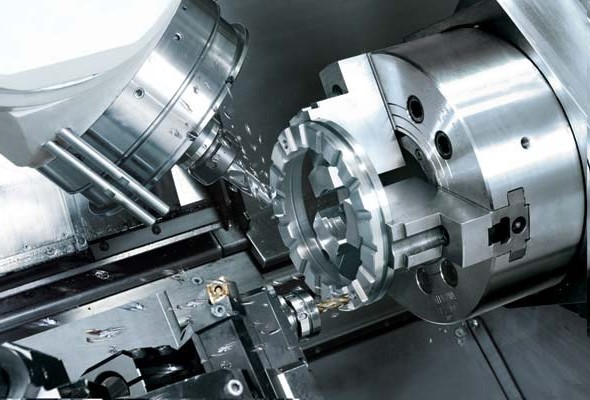Australian manufacturers need to be innovative to be competitive. There’s no such thing as cheap labour in this country. We need to maintain a sound understanding of new developments in CNC machining in order to maintain a competitive edge over imports, particularly with the Australian dollar so strong right now.

Sharp Tooling understands this. They have found it difficult competing with overseas product. Specialising in low volume jobbing work, they have turned their focus to technology that embraces Lean Manufacturing – especially the use of multi-tasking machines.
Multi-tasking CNC machines embrace the lean principles that form an integral part of today’s manufacturing landscape. They offer multiple manufacturing processes in a single machine. The flexibility of milling and turning in the same set up introduces a number of benefits such as reduced labour, reduced work in progress (WIP), improved quality and shorter lead times.
A multi-tasking machine has a built in milling capability comparable to a mill of similar specification. Simultaneous control over X, Z, Y, C and B axis delivers true multi-tasking. Couple this capacity with intuitive control and at least 20 tools already on the carousel and multi-tasking delivers a solution that embraces lean principles.
Example, consider producing a V block from round bar. Traditionally, a billet would be cut to length. It would then be milled, faced and chamfered in a 3 axis vertical machining centre. It would then be set up in a 4 axis vertical machining centre to mill the V and drill the holes. Upon completion of each process, the partially completed job represents WIP, which sits idle on the factory floor waiting on the next process. Each time the product is set for the next operation, an opportunity for error presents itself. Time in-between each process represents waste, in addition to the multiple times the incomplete component is handled by operators.
If we consider the V block for example as being produced on a multi-tasking machine, productivity savings can be realised by producing the component in a single set up on a 5 axis multi-tasking machine. Firstly, only a third of the plant is required to produce the component. Secondly, it can be produced in less than 1/6 of the processes. Thirdly, less than ¼ of the labour is required. That’s a pretty staggering saving on a fairly simple part.
Multi-tasking machines should not be confused with multi function lathes. They both have their place in the manufacturing landscape. In the simplest form, multi function lathes only have capacity for 12 tools on the turret, which means faster tool changes during production, but more time to set up. Multi function lathes lack the B axis, which means they’re not as versatile. However, they also have their place and that is with high volume production.
The introduction of a lower turret on multi-tasking machines introduces another level of versatility and speed. The lower turret allows for faster tool changes, which justifies higher volumes whilst also delivering the versatility of B axis.
Multi-tasking machines have two features that set this technology apart from multi function lathes. Firstly, the B axis, which is the arc the head moves through offering the flexibility for contouring and hobbing as additional functions to the milling and turning which means most parts can come off the machine in a single set up. Secondly, the tool storage capacity lends this technology to ease of set up and shorter cycle times on low volume jobbing work. For example, 20 tools are ready to be called up on the Integrex J-200 by Mazak in its standard configuration with 36 and 72 as optional capacities.
Mazak multi-tasking
Multi-tasking machines have been around for a considerable amount of time. In the mid 1990s the Y axis was introduced to machines which allowed for milling flats and drilling off centre. However, it wasn’t until 1998 that the true potential of multi-tasking was realised. Since then, lower turrets and sub spindles have been introduced and controllers have become more user friendly with built in machining simulations and collision avoidance. In the last 12 months we’ve seen them become more ergonomic and affordable with tool changing at the front of the machines.
These machines embrace the principles of lean thinking by reducing WIP, inventory and stock. This has certainly been the experience of Sharp Tooling. Set up times are also reduced in that up to 80 tools can already be loaded in the machine and ready to be called up.
This style of machine particularly suits the jobbing shop that specialises in CNC machining. Most jobs need only be set up once. This reduces the labour involved in production. It reduces the number of machines required in a manufacturing process, which in turn reduces the opportunity for accumulated errors, whilst increasing the uniformity and accuracy of the component. Above all, the machine utilisation is increased and each machine delivers a much better return on investment.
